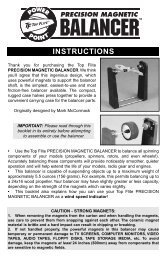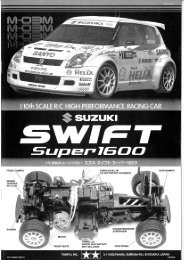THE TRX 3.3 RACING ENGINEWhen tuning forperformance, watch closelyto notice when there is nolonger any increase in speedor power when thehigh-speed mixture is lean.If you lean the high-speedmixture to the point that theengine cuts-out, hesitates,or stalls, you are well intothe danger zone and enginedamage is likely. Richen thehigh-speed needle 1/4 turnand retune.For your convenience, thelow-speed needle has apositive stop that preventsit from being over tightenedand damaging the needleand seat. This also providesan easy way to gauge howmany turns out from closedthe low-speed needleadjustment is set to.26 • JATO 3.314Winter Break-in TipsDuring the break-in process, the piston and sleeve wear intoeach other to form a precise fit. The engine needs to heat up to atemperature around 200 to 215°F to allow the piston and sleeve toachieve this fit properly. A precise fit between these two componentsis critical for proper compression, and optimum performance. If theengine runs too cold during break-in, the piston and sleeve will notexpand to their appropriate sizes for break-in, and this can lead topremature wear of these components. This wear may not becomeapparent until after winter has past, and the engine is operated underwarmer running conditions.Warm the engine to approximately room temperature by removingall fuel and storing the vehicle inside at room temperature until justbefore starting the engine. An extremely cold engine can becomedifficult to start.After the engine is running, it is important to keep the temperatureof the engine up around 200 to 215°F during break-in. In weatherbelow 45°F, the TRX 3.3 Racing Engine will tend to run at lowertemperatures between 160 to 180°F (when tuned at proper break-inmixture settings). This is too cool for break-in. Do not lean the fuelmixture to increase engine temperature! This will also decreaselubrication and cause your piston/sleeve to wear prematurely.Wrap the cooling head with a paper towel,clean rag or sock to help keep the enginerunning around the recommended 200to 215 break-in temp. If too much heatis contained, the engine can actually runtoo hot. Make sure that you monitor theengine’s temp closely for the first coupleof tanks until you get the right amount of cover for the cooling head.This will, of course, depend on your current weather conditions.Adjusting the cover up and down, exposing more or fewer coolingfins, is a convenient way to regulate engine temps.For owners that do not have access to a temperature probe, a dropof water on the cooling head (around the glow plug area) can beused to estimate the engine’s temperature. The drop of water shouldslowly sizzle for approximately 6 to 8 seconds if the engine is around200 to 210°F. If the water sizzles for only a few seconds, then it is likelythat it is over 220°F, and needs to cool down. If the water takes a longtime or does not evaporate at all, then the engine is too cool.We do not recommend that you operate your engine below 35°Fahrenheit. If you insist on running your vehicle below 35°F, be awarethat nitro engines may be very difficult to start and tune at extremelycold temperatures. Also, at temperatures below freezing, nitro fuelcan actually begin to gel up, and this can be harmful to the engine.Follow the remaining break-in procedures as outlined in this Owners<strong>Manual</strong>. This, along with the steps listed above, will ensure a good breakinfor your new nitro engine, and provide many hours of enjoyment.TUNING YOUR TRX 3.3 RACING ENGINEThe engine’s performancedepends on the fuelmixture. Turn the mixtureneedles clockwise tolean the fuel mixture andcounterclockwise to richenit. Leaning the fuel mixturewill increase enginepower up to the engine’smechanical limits. Neverrun the engine too lean(not enough fuel flow).Never lean the engine sofar that it begins to cutoutor stall. Leaning theengine beyond the safeallowable limits will resultin poor performance andalmost certain enginedamage. Indications of anoverly lean mixture include:Cutting out or sudden loss of power during acceleration.Overheating (temperature beyond 270° F at the glow plug).Little or no blue smoke coming from the exhaust.If any of these conditions are present, stop immediately and richenthe high speed mixture 1/4 turn. The engine will probably be slightlyrich at that setting and you can then retune for performance. Alwaystune for performance by starting rich and moving leaner toward theideal setting. Never try to tune from the lean side. There should alwaysbe a light stream of blue smoke coming from the exhaust.
THE TRX 3.3 RACING ENGINEBefore you begin tuning, the engine should be warmed up to its normaloperating temperature and running slightly rich. All final tuning adjustmentsmust be made to the engine at its normal operating temperature. You cantell the engine is running rich by noting any of the following:Sluggish acceleration with blue smoke coming from the exhaust.Jato may not shift into second gear.There is unburned fuel spraying from the exhaust tip.Leaning the high-speed fuel mixture increases performance.High-Speed Fuel Mixture AdjustmentWith the engine warm and running at a rich setting, gradually lean thehigh-speed fuel mixture in 1/16 turn increments. Make several highspeedpasses after each adjustment to clear out the engine and note anychange in performance. The TRX 3.3 is extremely powerful. Rememberto apply the throttle gradually to prevent wheelies or loss of control.Continue this procedure until there is no longer any performanceimprovement. If any one of the following conditions occurs, the fuelmixture is already past the maximum safe lean setting:1. There is no longer any performance improvement.2. The engine begins to cut out at high speed (Danger!).3. There is a sudden loss of power during acceleration (Danger!).4. The engine begins to overheat. Symptoms of overheating include:Steam or smoke coming from the engine (not exhaust).Hesitation or stalling during acceleration.Popping or clattering sound when decelerating (detonation).Fluctuating idle speed.Temperature measurement above 270° F at the glow plug(A temperature reading above 270° alone does not necessarilyindicate overheating. Look for other symptoms of overheatingcombined with temperature for a more accurate warning).Richen the fuel mixture to the optimum setting by richening thehigh-speed needle at least 1/8 turn counterclockwise and retest. Thissetting will extend engine component life.Low-Speed Fuel Mixture AdjustmentThe low-speed mixture is always set after the high-speed needle iscorrectly adjusted. The low-speed mixture is set using the “pinch test”:1. Once the engine is warm, do several high-speed runs to confirmthat the high-speed needle is set correctly.2. Bring the vehicle in and pinch closed the fuel line going into thecarburetor (use the engine shut-off clamp). The engine should run for2-3 seconds, speed up, and then shut off.3. If the engine runs longer than 3 seconds, then lean the low-speedneedle 1/16 turn, make several more high-speed runs, and retest.4. If the engine shuts off immediately without speeding up, then richenthe low-speed needle 1/8 turn, make several more high-speed runs,and retest.When the low-speed needle is set correctly, the engine’s throttle responseshould be very quick, even to the point of making it difficult to keep Jatofrom doing a wheelie when you accelerate!Fuel Mixture Adjustment ChartIf the...HumidityPressure(barometer)TemperatureAltitudeNitro %is..LowerHigherthen the airdensity is...Slightlymore denseSlightlyless denseLower Less dense LeanerHigher More dense RicherLower More dense RicherHigher Less dense LeanerLower More dense RicherHigher Less dense LeanerLower - LeanerHigher - Richeradjust (correct) thefuel mixture to be...Slightly richerSlightly leanerWhen adjusting the lowspeed fuel mixture, it is veryimportant to make severalhigh-speed runs with Jatobetween adjustments toclear out any excess fuel.Perform the pinch testimmediately after. If theengine is allowed to idlefor a long period of time, itcould “load up” with fueland give you an inaccuratemeasurement from yourpinch test.Higher nitro requires a richerfuel mixture. When running33% fuel, richen your highspeedneedle 3/4 turn ifpreviously running 20%nitro and then re-tune theengine for maximumperformance. See page 18for more informationJATO 3.3 • 27

















